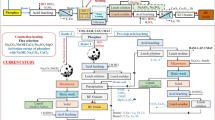Abstract
The recovery of valuable materials such as aluminum, phosphor powder, and glass from spent fluorescent lamps (SFLs) is part of the overall recycling process of lamps. In the end-cutting process, an SFL is separated into a base cap and a glass part using thermal shock caused by the temperature difference between the heating unit and the cooling unit. The separation efficiency of the end-cutting system is estimated by measuring the mass of the parts of the SFL. The optimum condition of the end-cutting process with thermal shock was determined to have a temperature difference of 600 °C and moving speed of 2 cm/s. At optimum conditions, the separation efficiency of glass and the end cap from an SFL using the end-cutting method is estimated to be more than about 97 %. In an air injection system, however, the separation efficiency of phosphor powder from glass is less than 50 %. Separation efficiency in the end-cutting system is increased by decreasing the moving speed of the SFL and increasing the temperature difference between the heating unit and the cooling unit. From the results of experiments, it was found that the end-cutting unit has very high performance because the overall separation efficiency is more than 95 %.

Similar content being viewed by others
References
Ministry of Environment (2011) Waste management act in Korea
Truesdale RS, Beaulieu SM, Pierson TK (1993) Management of used fluorescent lamps: final report. Prepared, Science Applications International Corporation
USEPA (2005) Introduction to Universal Waste, Solid Waste and Emergency Response
USEPA (1997) Mercury Emissions from the Disposal of Fluorescent Lamps, Final Report
MRT End-Cut Machine (2009) http://www.mrtsystem.com/images/pagepics/ECM.pdf. Accessed 15 June 2012
Balcan Lamp Recycling Systems (2006) http://www.cfl-lamprecycling.com/library/MP8000_Information_Pack.pdf. Accessed 11 July 2012
NEMA (2000) Environmental impact analysis: spent mercury-containing lamps
USEPA (2009) Fluorescent Lamp Recycling, EPA530
USEPA (2007) Fluorescent lamp disposal and recycling in EPA Region 2, a guide for businesses in NJ, NY, PR and VI
USEPA homepage. http://www.epa.gov/rcraonline. Accessed 22 Oct 2012
Vesilind PA, Worrell WA, Reinhart DR (2002) Solid Waste Engineering. BROOKS COLE Publishing Company, USA
Rhee SW (2003) A study on aluminum recovery from spent fluorescent lamps using roll crush system. J Korea Soc Waste Manag 20(6):612–619
Durao WA Jr, Castro CA, Windmoller CC et al (2008) Mercury reduction studies to facilitate the thermal decontamination of phosphor powder residues from spent fluorescent lamps. Waste Manage (Oxford) 28:2311–2319
Jang M, Jang M, Hong SM, Park JK et al (2005) Characterization and recovery of mercury from spent fluorescent lamps. Waste Manage (Oxford) 25:5–14
Huber ML, Laesecke A, Friend DG (2006) The vapor pressure of mercury, NITS, NISTIR 6643, USDOC
Hirajima T, Bissombolo A, Sasaki K, Nakayama K, Hirai H, Tsunekawa M et al (2005) Floatability of rare earth phosphors from waste fluorescent lamps. Int J Miner Process 77:187–198
Hirajima T, Sasaki K, Bissombolo A, Hirai H, Hamada M, Tsunekawa M et al (2005) Feasibility of an efficient recovery of rare earth-activated phosphors from waste fluorescent lamps through dense-medium centrifugations. Sep Purif Technol 44:197–204
Battye W, McGeough U, Overcash C (1994) Evaluation of mercury emissions from fluorescent lamp crushing, air pollution. Technical Report EPA-453/R-94-018
Acknowledgments
This study was partially supported by the R&D center for Valuable Recycling (Global-Top Environmental Technology Development Program) funded by the Ministry of the Environment, Korea (project no. GT-11-C-01-070-0).
Author information
Authors and Affiliations
Corresponding author
Rights and permissions
About this article
Cite this article
Rhee, SW., Choi, HH. & Park, HS. Performance evaluation of material separation from spent fluorescent lamps using the thermal end-cutting method. J Mater Cycles Waste Manag 15, 503–509 (2013). https://doi.org/10.1007/s10163-013-0172-3
Received:
Accepted:
Published:
Issue Date:
DOI: https://doi.org/10.1007/s10163-013-0172-3




